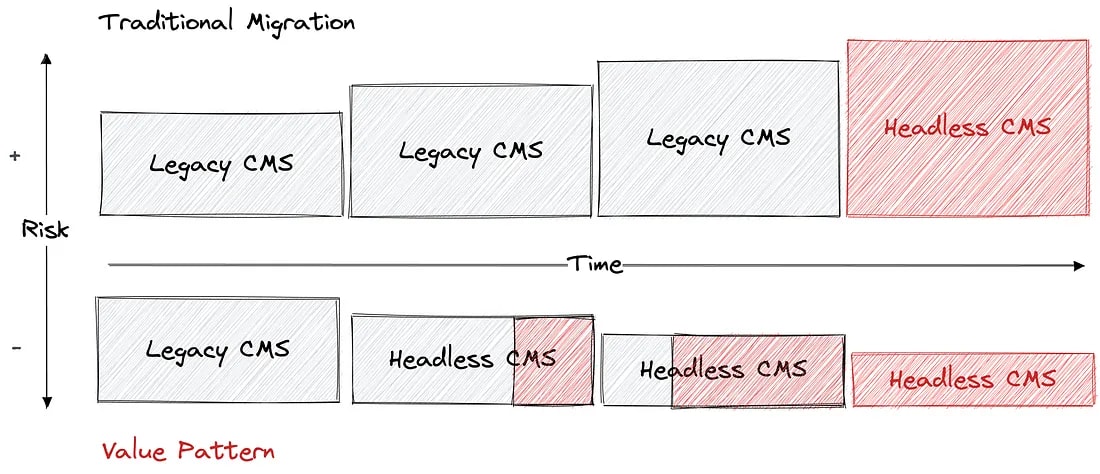In the dynamic world of digital content, a Content Management System (CMS) is the beating heart that drives a brand’s online presence. A robust CMS enables businesses to manage and publish their digital content effectively and plays a vital role in engaging audiences and driving conversions. However, as technology and user demands evolve, a traditional CMS may no longer provide the flexibility and performance needed. Enter the realm of headless CMS, a forward-thinking alternative that allows brands to deliver rich content experiences across multiple platforms with unprecedented agility.
While the thought of migration from a traditional CMS to a headless CMS may seem daunting, there’s a new approach that can make this transition smoother and less risky: The Value Pattern. The name may sound unfamiliar, but the concept will resonate with anyone who has faced the puzzle of upgrading their system without disrupting ongoing operations.

The Value Pattern for CMS Migration
In contrast to the ‘Big Bang’ or turnkey migration approaches, which often involve completely overhauling the system all at once, the Value Pattern is more evolutionary. It allows for a gradual transition, where the new system grows in parallel with the old, slowly taking over functionality until the old system can be safely retired.
In this comprehensive guide, we will delve deep into the world of headless CMS, the migration challenges often faced by businesses, and how the Value Pattern provides a powerful, flexible solution for seamless migration.
Understanding CMS migration
Digital technology is constantly changing, and staying competitive means adapting to these changes swiftly and efficiently. Content Management Systems (CMS) are no exception. As the backbone of your digital presence, the CMS you utilize can significantly impact your business’s ability to engage audiences, manage content and, ultimately, drive growth.
Traditionally, CMSs were monolithic structures, with frontend and backend systems tightly coupled together. It means that changes to one part of the system often affect others, leading to a complex, slow, and inflexible process. Businesses were tied to specific presentation layers and often found it challenging to deliver content across multiple platforms or to adapt to new technologies or trends rapidly.
Enter the headless CMS, a game-changer in the world of digital content management. In a headless CMS, the backend and frontend are decoupled, allowing content to be created and managed separately from its presentation. Moreover, content can be delivered across various platforms — a website, mobile app, IoT device, or even AR/VR applications — with remarkable ease and consistency. The benefits are manifold:
- Enhanced flexibility
- Quicker time to market
- Scalability
- The ability to keep up with the ever-evolving digital landscape
However, the transition from a traditional CMS to a headless one is not without its challenges. The CMS migration process involves moving existing content and functionality from the old system to the new one. It’s a complex task that requires careful planning, resource allocation, and execution.
The most common approach to migrations is the ‘Big Bang’ or turnkey migration. Here, the entire system is replaced at once, with content and functionality moved to the new CMS at some stage in the process. While this approach may seem efficient, it comes with many risks. It is often disruptive, high risk, and requires significant upfront investment before producing any return on investment. In addition, any unforeseen issues during the migration can lead to extended downtime and extra costs, negatively affecting business operations. Moreover, such a major change can be stressful for team members, who must quickly adapt to the new system.
Here is where the Value Pattern comes into play. Offering a more gradual, controlled migration approach, the Value Pattern allows for incremental changes, reducing the potential for disruption and making the migration process more manageable. In the following sections, we’ll delve deeper into what the Value Pattern entails and how it contrasts with the Big Bang approach in migrations.
The Value Pattern
As we navigate the terrain of CMS migration, it’s essential to understand that every journey is unique, and every destination has its own set of challenges. However, the path we choose can make a significant difference in how efficiently we overcome these challenges. The Value Pattern provides an evolutionary path for CMS migration, enabling risk mitigation, control, and adaptability while focusing on time-to-value. In other words, the goal is to generate a return on investment as early as possible, where sunsetting the legacy system is just one element of the strategy to generate more value.
This pattern takes inspiration from the strangler fig tree, which begins as a seed that lands on a host tree. As it grows, it sends roots down the host’s trunk while reaching toward the sunlight. Eventually, it covers the host tree completely, replacing it. However, the strangler fig does not harm the host but survives it by growing in the spaces left by its decay. This metaphor powerfully illustrates the Value Pattern, where our fig tree prioritizes producing high-quality fruit quickly.
In the context of CMS migration, the Value Pattern approach involves building the new headless CMS in parallel with the existing traditional CMS. Instead of trying to migrate everything at once, you identify key areas of functionality or content and migrate them one at a time. The new system gradually takes on more workload as each piece is moved. This method allows the new CMS to grow around the old one, eventually replacing it entirely.
This process’s beauty lies in its incremental nature. Unlike the ‘Big Bang’ approach, which could be likened to uprooting and replanting a tree, the Value Pattern lets the new system grow organically, taking over the responsibilities of the old system piece by piece. This results in minimal disruption to ongoing operations, reduces risks and overall workload, and allows for more effective quality control, as each part is tested and improved before the next is migrated.
In the following sections, we will explore the step-by-step process of the Value Pattern, compare it with the Big Bang approach, and explain why it’s a smart choice for businesses planning to migrate to a headless CMS. Whether you’re an SME or a large enterprise, understanding and adopting the Value Pattern can be the key to a successful value-generation CMS migration.
The Value Pattern Process
The beauty of the Value Pattern lies in its flexibility. Breaking down the massive task of a CMS migration into manageable chunks mitigates risks, minimizes disruption, and offers an opportunity for incremental learning and continuous improvement. Let’s look into this organic approach step by step:
Step 1: Identify Key Areas for Migration and Prioritize Them
The first step in the Value Pattern approach involves identifying and prioritizing the functionalities or content areas to be migrated. It requires a thorough analysis of your existing CMS and an understanding of which areas would benefit most from the headless CMS’s features. These could be areas that require frequent updates, have high user interaction, drive revenue, or need to be displayed across multiple platforms.
Remember, the goal isn’t to migrate everything at once but to start with critical areas that will give you the most value. Prioritizing areas based on business value, technical feasibility, and user impact can guide your migration strategy.
Step 2: Build the New System in Parallel
Once you’ve identified the first area to be migrated, start building that functionality in the new headless CMS. It is done in parallel with the existing system, which continues to operate as usual. The new CMS should have the necessary infrastructure, integrations, and workflows to support the duo operation.
During this stage, engaging all relevant stakeholders, including content creators, developers, and end-users, is important to ensure the new system meets their needs and expectations. In addition, automation testing and feedback loops are critical to ensure quality and usability.
Step 3: Gradual Cutover to the New System
It’s time for the cutover once the new functionality is ready and tested. The new headless CMS now handles all requests for that particular functionality. The old system still handles other functionalities, but the new system has taken over for this specific area.
Monitoring the new system closely during this period is recommended to catch any issues early and ensure a smooth transition. Again, keep communication channels open with all stakeholders to gather feedback and make necessary adjustments.
Step 4: Repeat for the Next Area
Once you’ve successfully migrated the first area and are satisfied with its performance in the new CMS, it’s time to repeat the process with the next area on your priority list. Identify the next functionality, build it in the new system, and gradually cut over.
Step 5: Retire the Old System
This iterative process continues until all functionalities have been migrated to the new headless CMS. At this point, the old system can be safely retired. You have successfully strangled the old CMS, replacing it entirely with the new, more agile, and flexible headless CMS.
The Value Pattern is not just a method but a philosophy that places control, risk mitigation, and continuous improvement at the heart of CMS migration.
In the next article of this series, we discuss the benefits of adopting the value pattern approach for your CMS migration and use cases to see it in action.



